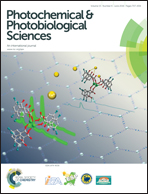A quantitative structure–property relationship (QSPR) study of singlet oxygen generation by pteridines
Abstract
The QSPR method is used in photochemistry for the prediction of the absorption wavelength, fluorescence intensity, photolysis quantum yield, etc. However, to our knowledge, no attempts have been made to use the quantum yield of singlet oxygen (1O2) generation (ΦΔ) as an analyzed parameter in a QSPR study. We performed QSPR analysis of 29 pteridine compounds (including pterin and flavin sensitizers) for their ability to produce singlet oxygen in aqueous (D2O) solutions. Pteridines are ubiquitously present in living systems (mostly as coenzymes), possess high photochemical activity and have multiple applications as photosensitizers. Our goal was to develop a QSPR model for the fast virtual screening and prediction of the 1O2 generation quantum yield of pteridines. Quantum-chemical descriptors were calculated using the AM1 semi-empirical method. The ability of pteridines to generate singlet oxygen was found to be significantly correlated with the HOMO orbital energy (R2 = 0.806) and electronegativity (R2 = 0.840). The best QSPR model obtained using electronegativity, dipole density and electrostatic charge of the N3 atom of the pteridine system allows us to predict ΦΔ of pterin and flavin photosensitizers. The model possesses high internal stability (q2 = 0.881), as well as high predicting ability for the external dataset (pred_R2 = 0.873). More QSPR analysis is needed for the prediction of ΦΔ of pteridines and other groups of sensitizers in aqueous as well as in non-polar solutions.


 Please wait while we load your content...
Please wait while we load your content...